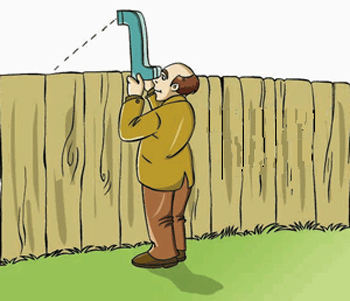scopo-, scop-, scept-, skept-, -scope-, -scopy, -scopia, -scopic, -scopist
(Greek > Latin: see, view, sight, look, look at, examine, behold, consider)
2. Artificial feeding through a tube passed through the skin into the stomach.
Percutaneous endoscopic gastrostomy is a surgical procedure for placing a feeding tube, but it does not necessitate doing an open laparotomy (operation on the abdomen).
The aim of PEG (as with any gastrostomy) is to feed those who can not normally swallow their food. Percutaneous endoscopic gastrostomy may be done by a surgeon, otolaryngologist, or a gastroenterologist. It is usually done in a hospital or outpatient surgical facility.
See gavage for information about a similar procedure.
2. A long tubular optical instrument; for example, on a submarine, that uses lenses, prisms, and mirrors to allow a viewer to see objects not in a direct line of sight.
3. An optical instrument for viewing objects that are above the level of direct sight or in an otherwise obstructed field of vision, consisting essentially of a tube with an arrangement of prisms or mirrors and, usually, lenses; used especially in submarines.

A man is looking over a fence at the construction of an apartment building that is beginning in his neighborhood.
2. Periscopic spectacles, spectacles having concavo-convex or the convexo-concave lenses with a considerable curvature corresponding to that of the eye, to increase the distinctness of objects viewed obliquely.
3. A reference to periscopes or their uses.
Such wrinkles are undesirable because they represent aging and there are many who desire, and get, cosmetic surgery so they can appear more youthful.
Cross references of word families that are related directly, or indirectly, to: "appear, visible, visual, manifest, show, see, reveal, look": blep-; delo-; demonstra-; opt-; -orama; pare-; phanero-; phant-; pheno-; spec-; vela-, veal-; video-, visuo-.


